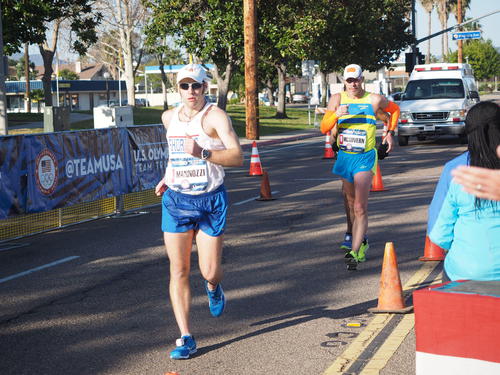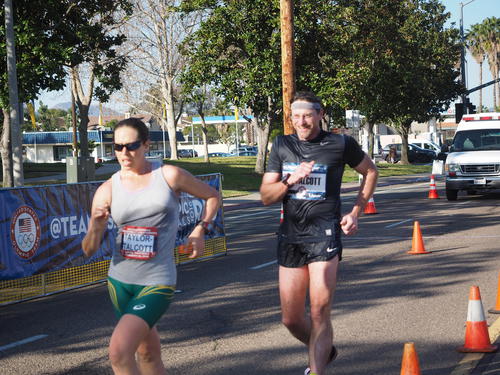 John Nunn and Nick Christie on the course lapping Erin Taylor-Talcott, photo by Calvin Lau
John Nunn and Nick Christie on the course lapping Erin Taylor-Talcott, photo by Calvin Lau
The longest, and most grueling event on the Olympic schedule is the 50 kilometer walk. It is also one of the events that has the longest historic (the writer of Frankenstein was a race walker).
Elliott Denman wrote this piece for us on the US Olympic Trials, one week after the US marathon Trials.
THE FIFTY K
REMAINS THE TOUGHEST
OF ALL OLYMPIC TESTS
BY ELLIOTT DENMAN
John Nunn’s going to Rio.
As, most likely, the lone American delegate in the longest and toughest of all Olympic and World Championships disciplines.
Consistency – that’s John Nunn for you. He’d won the USA National 50-Kilometer (31.1-mile) racewalking championship in Santee, California last November in 4:03.40.
And he returned to that venue – actually a 1.25K loop past Santana High School traversed 40 times – last Sunday, February 21st, to win the USA Olympic Trial race in 4:03.21.
Is this man a metronome, or what?
Consider, he’d done two races, of a combined 100K, or 62.2 miles, and compiled clockings just 19 seconds apart.
Truly-truly amazing, that’s what this picture-of-consistency, 38-year-old U.S. Army staff sergeant surely is.
With the Olympic “A” qualifying time set at 4:06:00, and heat providing less than optimal conditions, Nunn stillstepped onto the Road to Rio with over a quarter-mile to spare. It will be his third Olympic team – he’d placed 26th in the 20K at Athens in 2004, and 43rd in the 50K at London in 2012.
 Mike Mannozzi in solo effort ahead of record eight-time participant in Olympic Triasl Dave McGovern, photo by Calvin Lau
Mike Mannozzi in solo effort ahead of record eight-time participant in Olympic Triasl Dave McGovern, photo by Calvin Lau A step up into the top half of the 50K field at Rio would be nice but, American fans, don’t count on it. There’s just too much catching up to do. The world leaders, unfortunately, have half an hour’s head start on America’s number one.
Stands to reason, when you think about it.
Racewalking is built into the infrastucture of so many other nations’ track and field programsbut it’s surely not that way in the U.S. of A. The only American racewalkingfarm systems can be found at NAIA, small-college programs; the hit-and-miss USATF and AAU Junior Olympic slates, and the here-and-there club teams scattered around the land.
So Nunn, a single dad, dental hygienist and U.S. Army World Class Athletic Program(WCAP) member, now a resident of the San Diego area, but originally out of Evansville, Indiana, becomes the notable exception and certainly not the rule.
“It makes you realize how strong the human mind can be,” said Nunn, not long afterhe’d completed his 50K and with it the freedom to unlace his racing shoes.
He’d been nursing a variety of the flu. He’d tossed and turned all the night before. It took him nearly two hours into the race before feeling “close to OK.” But he kept on churning out those miles at a 7:50 clip and never relented.
John Nunn knew he’d poured too much of himself – body and soul – to take a breather now. Another “amazing” journey – to Rio – was his hard-earned reward.
His daughter Ella, 11, provided course-side encouragement throughout.
Later, she called it “a super-exciting experience.”
“I don’t know if I could be any happier,” she told people.
Walker-up Nick Christie wasn’t close to his 4:11:48 PR walk of last November but stillhung on to second place in 4:22:31. Michael Mannozzi claimed third with a solid4:31:47. They’d have until early May to get under the Olympic 4:06 requirement, and realize they’re still longshots.
Special applause was reserved for Erin Taylor-Talcott, who for years has been recognized for her pioneering efforts promoting women’s long distance events – note that the 50K is the lone men’s Olympic/Worlds event that has no women’s equivalent – and finished this one in 4:44:26, ranking sixth over-all.
And more cheers were there for Jonathan Matthews and Dave McGovern for very special achievements of their own. Never a threat to Nunn or the other leaders,Matthews still crossed the line seventh in 5:03:26; just 131 days shy of his 60th birthday, as the oldest male athlete ever to qualify for the Track Trials.
Further back still, 11th in 5:31:25, McGovern became the first man ever to complete his event in eight Olympic Trials. He’d never made an Olympic team – but never stopped trying, either.
Once upon a time, the “4s” were a formidable barrier in track and field.
Until May 6, 1954, when Roger Bannister ran a mile in 3:59.4 in Oxford, England.
And October 17, 1965, when Gennadiy Agapov racewalked 50 kilometers in 3:55.36 in Alma-Ata (now Almaty), Kazakhstan.They’d finally bested the sub 4-mile run and the sub-4 50k walk.
Few devotees of the sport drew that link – but they should have.
The sub- four-minute mile had often been called an “impossible” achievement untilDr. Bannister proved otherwise.
The sub-four-hour 50K had similarly been considered “too far out there” for norma lfolks to contemplate.
But now each of those feats is ranked as a commonplace achievement, done routinely, again and again and again.
When Joshua Thompson of Oklahoma State crossed the finish line in 3:58.33 in a Seattle indoor meet February 13th, he became the 466th and most recent American mile runner to “crack 4.” On a list that began with Don Bowden’s 3:58.7 on June 1, 1957.
“Routine” can not, however, be applied to the American 50K racewalk list.The sub 4-50k is surely not commonplace to those wearing USA singlets.
Just nine American walkers – ever-ever-ever – have gone sub-4. The first was Marco Evoniuk, with his 3:56:57 at the 1983 World Championships in Helsinki. The most recent was Philip Dunn, with his 3:56.13 at the 2002 World Cup in Torino(meaning a drought of 14 years).
Curt Clausen is the resident USA expert on the art of sub-4-ing. He’s gone sub-4 no less than four times – and set the American record of 3:48.04 at the 1999 World Cup in Spain.
Other members of this elite American “sub-4 club” are Allen James (3:55.39 in 1994), Carl Schueler (3:57.09 in 1987), Andrew Hermann (3:57.54 in 2000), Andrzej Chylinski (3:58:59 in 2000), the late Al Heppner (3:58.45 in 1999) and Herm Nelson (3:59.41 in 1996.)
 Erin Taylor-Talcott doing her thing, which included passing hubby Dave, photo by Calvin Lau
Erin Taylor-Talcott doing her thing, which included passing hubby Dave, photo by Calvin Lau Even an Olympic bronze medal performance by Larry Young (with his 4:00.46 at the 1972 Munich Games) doesn’t make the cut. He’s just 10th all-time on the U.S. 50K list.
And John Nunn’s still stuck in 12th all-time.
Still plus-four at 4:03:21.
Bottom line: the “barrier” is as formidable as ever, and don’t count on it
coming down soon, either.
(NOTE: Elliott Denman was the 1959 USA 50K racewalk champion; he placed 11th in the 50K at the 1956 Melbourne Olympic Games.)
One of the finest and most prolific writers in our sport, Elliott Denman has written about our sport since 1956, when he represented the US in 1956 Olympic Games at the 50k race walk, the longest event on the Olympic schedule. A close observer of the sport, Elliott writes about all of our sport, combining the skills of a well honed writer with the style of ee Cummings. We are quite fortunate to have Elliott Denman as a friend and advisor.
View all posts
 John Nunn and Nick Christie on the course lapping Erin Taylor-Talcott, photo by Calvin Lau
John Nunn and Nick Christie on the course lapping Erin Taylor-Talcott, photo by Calvin Lau Mike Mannozzi in solo effort ahead of record eight-time participant in Olympic Triasl Dave McGovern, photo by Calvin Lau
Mike Mannozzi in solo effort ahead of record eight-time participant in Olympic Triasl Dave McGovern, photo by Calvin Lau Erin Taylor-Talcott doing her thing, which included passing hubby Dave, photo by Calvin Lau
Erin Taylor-Talcott doing her thing, which included passing hubby Dave, photo by Calvin Lau




















